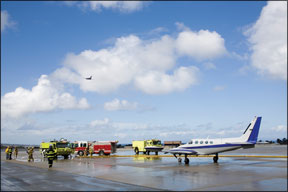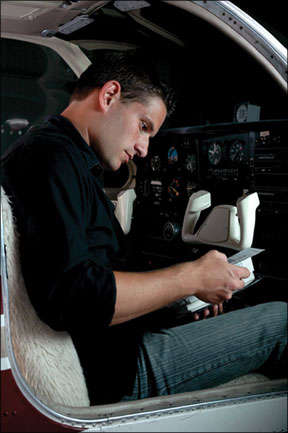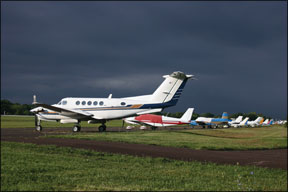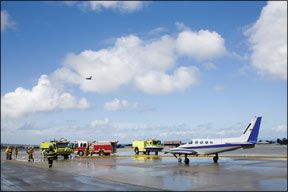One of the sad realities of general aviation becomes apparent upon reading a score or so NTSB accident reports: While true in-flight emergencies are rare, pilots who do not fly for a living have a less-than-stellar record of success when they stare one in the face. It is a blunt corollary to the simple fact that anything a human doesnt practice regularly doesnt get done well the next time its needed. Thats 288 why pilots who take recurrent training every six months tend to have far, far fewer accidents than pilots who only grudgingly take a flight review every 24. No matter how we try to sweep the mess under the rug, skills atrophy fast and anything we dont practice regularly we, sadly, screw up. Those who study human behavior have long been telling us this stuff, they just use bigger words. We know it. We know perfectly well that if we are faced with an emergency when we go flying tomorrow that how we handle it has already been determined. If weve thought about that particular emergency (or one very similar) and how we will deal with it, the odds of handling it correctly are astronomically higher than if we havent given it any thought. If weve actually rehearsed dealing with the emergency in the last six months, the odds that well deal with it correctly go way, way up. Being human, we do well what we do often. We do landings all the time. We dont do fires in flight nearly as frequently. Obstacles We all know we need to think about and practice emergencies on a regular basis. But pilots are famously reluctant to spend money on things that arent fun. Thoroughly mix that reluctance with a somewhat natural and even stronger aversion to taking anything that is perceived as a checkride. The result, perhaps quite reasonably, is pilots who know full well that spending half a day with an instructor every six months is the right thing to do. But they simply arent going to do it unless forced. So, we recognize the need to practice emergencies in the airplane every six months or so, but it remains an expense and exercise in which most nonprofessional pilots are unwilling to engage. Is there any sort of compromise to help tip the scales toward pilots becoming garrulous bores in retirement homes instead of the subjects of NTSB reports appearing in the back pages of this very magazine? Are we all destined to have our last flights used in classrooms as bad examples should the engine pack it in 100 feet off the ground after takeoff, or the carbon monoxide indicator starts a frantic beeping? Nope. Were hosed. Turn to the next article. Sorry-youre not going to get off that easy: We wouldnt be publishing this unless we could tell you about ways to improve your odds of survival when things go bad. There is a way to have your proficiency training and the money youd spend on it. It involves a little quiet time to yourself. It is based on what every flight instructor has observed since the Wrights started their flight school: a pilot who actually thinks about flying between flights does a heck of a lot better than those who dont. While its not as good as taking six-month recurrent training in a full-motion sim, its a lot cheaper. The bottom line is you can still greatly increase your odds of safely handling an emergency through a two-step process: Think about what might go wrong and how you would handle it. Then sit down somewhere private and go through the motions of handling each emergency you considered. Making a List Lets break it down. Step one is to come up with a list of all the terrible things that can happen to you when you are flying an aircraft. For starters, take a look at section three, emergency procedures, of the Pilot Operating Handbook (POH) of the airplane you fly most regularly. (If you dont have a personal copy of the POH or a Pilot Information Manual, you really should. Failing that, its worth getting one or at 288 least photocopying the emergency procedures section.) This portion of the POH has a pretty good list of things that can go wrong, from engine failures to blown tires. Even better, it also has lists of what to do about each one. For example, with airframe ice, leave the flaps retracted when landing or, in the event of an engine fire, the POH tells you what to do with the cabin air vents-this stuff isnt the same for all airplanes. Its a good start for your parade of horribles, as college professors used to say. At this point you arent coming up with solutions, youre just listing bad stuff, frozen engine or flight controls, sudden blurred vision, bird strike, passenger-vomiting for distance, a window blowing out. Okay, not all those things are in your POH, but you get the idea. These are the sort of things that might go wrong in flight someday, and youll have to face them head-on. Making your list is a chance to be creative, although you probably shouldnt show the list to a white-knuckle passenger-some things are best kept among us pilots. Once you have your list, write down how each emergency should be dealt with. For the POH stuff, its easy; just write down what the manufacturer recommends and in the published order. Its usually pretty accurate. Plus, writing it down will help you remember it. For the other things, use the judgment you developed while coming this far as a pilot. If youve thought of the problem, chances are you can come up with a correct response. Besides, its a lot easier to come up with a correct response sitting in an easy chair during a quiet evening at home than in a noisy airplane, which may be making sounds youve not heard before, while bucking in turbulence as your spouse is asking about a bathroom break. If you get stumped on a solution, call a flight instructor you know and trust. Maybe offer to buy him or her a cold one, and have a pleasant hour or two just talking emergencies. Take notes and have the benefit of getting your mind working in a direction that will be productive in the future. Using It Now what? Once you have the list of nasty events and their antidotes, practice it. Practice it by going through each and every step for each and every emergency several times to make your actions instinctual. Visualize the emergency and what you are doing each step of the way. Move your hands to each control and consider precisely what they will be doing, how it will feel and what you will be seeing through the windshield and on the panel. While its outstanding if you can do this in flight or in a full-motion simulator, we are talking about more prosaic and less-expensive environments-a computer-based home simulator, for example, or simply the aforementioned easy chair. You might even be able to sit in your favorite rental airplane between renters. The idea is simply to do and think, and visualize what you are doing. During the Great Depression-no, the one that started some 80 years ago-there was a national radio program giving a 15-minute flying lesson. The instructor told the thousands of “students” listening throughout the country to sit in a comfortable chair and use a broomstick or baseball bat to simulate the control stick. One of the reason some pilots in the 30s soloed with much less than eight hours of instruction was that they had spent evenings listening to their radio, and pretending to fly while thinking about what the controls did and what the airplane would be doing. It works. Motor Skills The hand and foot movements involved with handling an emergency are important. I cant count the multi-engine pilots Ive spoken to who report it was difficult to feather a propeller after an engine had well and truly failed because they had never actually moved a propeller control into the feather position. During training, they 288 had just pulled it back to the high-pitch/low-rpm position. Some reported they were surprised at the movement required to pull it down and around the detent, or past the high-friction point to get it to the feather position. That explained to me why the NTSB reports show any number of multi-engine accidents in which there was a failed engine but the associated propeller was not ever feathered. When practicing engine failures in a multi-engine airplane, go through each hand movement to identify the dead engine, feather the propeller and shut off the fuel-without shutting off the fuel to the good engine, as has been done. Ask yourself: What are your hands going to do? What is it going to look like as you do it? What is the airplane going to do? Pre-Planning If the engine quits during the takeoff roll youre going to brake to a stop, right? Is there anything else you should be doing? How about pulling the throttle to idle so you dont get taken where you dont want to go should the engine momentarily come back to life? Think about that situation-you have just had the engine quit on takeoff. Isnt it incredibly stupid to go ahead with a takeoff if it suddenly begins running again? The dismal fact is that it is probably going to quit again, at a much worse location. It gave you one chance, dont ruin it. I dont know why so many pilots never thought about that scenario. They left the throttle forward when the engine quit. They got on the brakes and were steering the airplane straight ahead toward a safe stop. The engine came back to life and went to full power. Rather than pull the throttle back, they came off the brakes and continued the takeoff run. In a couple of cases the engine quit again when the airplane was a couple of hundred feet off the ground; in one case there wasnt much runway left, and the airplane went into the water off the end and a passenger drowned. What will it look and feel like as you hold a flat main or nose tire off of the runway as long as possible on landing? How will your hands be moving? Have you ever put the ailerons to the stop on landing? How will it look and feel? What will you expect when the tires touches the ground? What will you do? How will you do it? What will be the result? When The Time Comes Nature has always been a hanging judge. If you handle an emergency wrong, you wont get probation or time off for good behavior. The harsh sentence will be passed, immediately. Practicing for emergencies has always meant a better chance of getting it right the first time. Meanwhile, flying airplanes has never been cheap. Thinking about and practicing emergencies costs absolutely nothing. Any easy chair, a list of what can go wrong and what you are going to do about it (and developing some muscle memory) may well mean when that emergency does happen, youll have years and years to bore people as you tell them about how you successfully handled it rather than looking stupid in the NTSB report.






